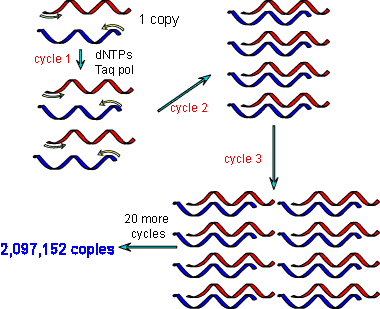
A brief introduction to Polymerase Chain Reaction (PCR)
Polymerase Chain Reaction (PCR) was invented by Kary B. Mullis in 1985 for which he was also awarded the Nobel Prize for Chemistry in 1993. In 1993, the first FDA-approved PCR kit came to market (1). PCR is a fast, reliable, and affordable laboratory technique to amplify small segments of DNA. It is undoubtedly considered as one of the most important scientific advances of the 20th century and has numerous applications in forensics, genetic testing, and diagnostics.
How does PCR work
To amplify a DNA segment using PCR, the sample is heated to denature the DNA and separate it into two single-stranded DNA. Then, the “Taq polymerase” synthesizes two new DNA strands using the original strands as templates which results into duplication of the original DNA. Each of these strands is used to create two new copies, and this automated cycle keeps on going in a thermocycler.
The PCR reaction has three basic steps:
1. Denaturation: Denaturation of the template DNA strands is the very first step to amplifying DNA. The double-stranded (ds) DNA is heated to break the hydrogen bonds between the complementary DNA. Denaturation results in the separation of the two DNA strands.
2. Annealing: In the second step, the temperature is decreased so that the primers can anneal to the complementary sequences on the DNA templates. Low temperature stabilizes the forward and reverse primers and allows new bonds to form between the sequences.
3. Extension: Extension results in two double-stranded products of DNA. The extension temperature depends on the DNA polymerase that is used. The optimal temperature for Taq polymerase to extend the primers in the 5′ to 3′ direction is 72°C. The extension time depends upon the synthesis rate of the DNA polymerase and the length of the target DNA.
These three steps are repeated 25-35 times to replicate the target DNA exponentially in a programmed thermocycler (2).
References
1. Kaunitz JD. The Discovery of PCR: ProCuRement of Divine Power. Dig Dis Sci. 2015 Aug;60(8):2230-1. doi: 10.1007/s10620-015-3747-0. PMID: 26077976; PMCID: PMC4501591.
2. Delidow BC, Lynch JP, Peluso JJ, White BA. Polymerase chain reaction: basic protocols. Methods Mol Biol. 1993;15:1-29. doi: 10.1385/0-89603-244-2:1. PMID: 21400259.



